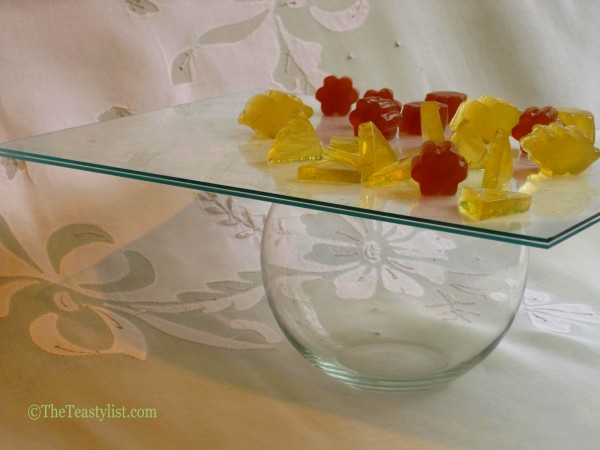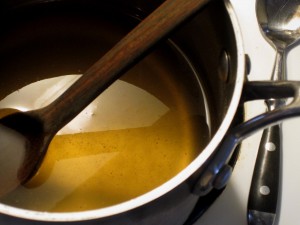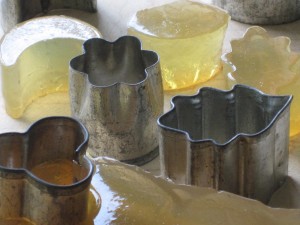Tea cuisine is still very much experimental. There will be successes and failures. The point is to keep trying. Since it is a relatively new culinary category, good ideas will eventually emerge and become part of tea’s repetoire.
Coffee has been used for decades in baking and alcoholic concoctions, but I believe that tea performs much better than coffee in savoury dishes. Could you imagine coffee encrusted fish? – I didn’t think so. This time out though, I’m playing with sweet. Jellied sweet, as in “wibble wobble”. I’ll tell you straight away that I consider it a winner. It succeeds because it’s easy, it looks pretty, has a fantastic texture and tastes fine.

Prep Steps
I prefer to drink my tea without added flavours, with the exception of traditionals eg. Masala Chai, ginger, Osmanthus, Lychee, etc. I have however, been given some flavoured teas that I think will work nicely for this jellying experiment. I used a variety of teas because I wanted a mix of colours on the plate, but one type of tea is fine. The seaweed-based Agar Agar (also known as Kanten) powder that I used is a different consistency than animal-based gelatin. It is denser and colder to the touch – you have to try it to understand what I mean by that. You can purchase a 170g (6 oz) box for a few dollars at an Asian supermarket.
Here’s what I used:
- David’s Tea “Hot Lips”, a blend of green tea, cinnamon, saffron, pink peppercorns and chili pepper.
- Tea Source “Green Mango“:, a Sencha-based green tea with mango flavouring and sunflower petals
- Harney and Sons “Vienna 1900”, an Earl Grey-type custom blend for the Sabarsky Cafe at the Neue Gallery, NYC
- Agar Agar powder, a mixture of seaweed-based jelly powder and sugar
- For each tea, line a loaf pan with parchment paper.
- Hors D’Oeuvre cutters work well, but you could also just cut square or diamond shapes with a knife.

The measurements below are for each tea:
- Make a stronger tea infusion than you might normally like to drink. The sugar in the powder will balance any astringency. I used 5g (approx. 3 tsps) dry leaf for each tea. I let the tea steep for 3 minutes
- Add 3½ Tablespoons of agar agar powder to 1½ Cups prepared tea
- Put tea and powder in a small sauce pan and stir on high heat to dissolve crystals. As soon as the mixture starts to bubble, turn heat down to medium and stir for one minute. Remove from heat.
- You can’t leave the mixture sitting around for too long because unlike animal-based gelatin, agar agar gels quickly as it cools down.
- Once it has cooled to room temperature, the jelly should be firm. Turn out onto a flat surface.
- Cut shapes with a knife or cutters.
- Will keep for approx. 5 days in the fridge, but I kept some out overnight and it dried out a bit making it more “gummy”, so that’s also worth experimentation. Gummy teas anyone?
Taste Test
The difference in colour (pale yellow) between the two green teas was not noticeable, but the taste certainly was. “Green Mango” was a good choice for jellying with its fruity flavour. “Hot Lips” was my favourite – a sweet version of spiced jelly condiment. I’m sure you’d get the same effect if you used a peppery Chai. “Vienna 1900” was a rich garnet colour and tasted clearly of sweetened Earl Grey. The overall texture of the tea jellies seemed less melt-in-your-mouth than gelatin, but heftier and with more presence. Tea taste was present, but not dominant. The point of the exercise was not to taste tea but to play with it by combining it with a new medium and texture. I believe it was a successful fusion. Let me know of other teas that would be good candidates for jellification!





